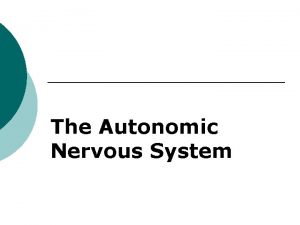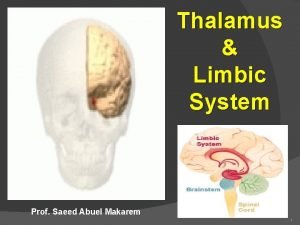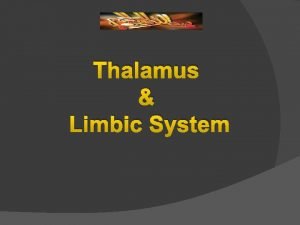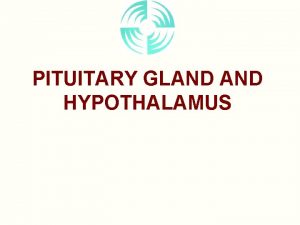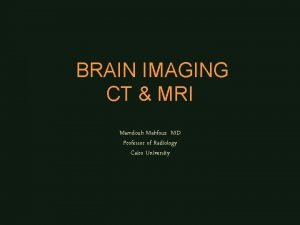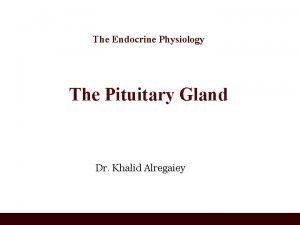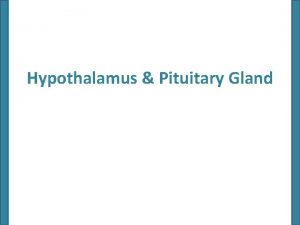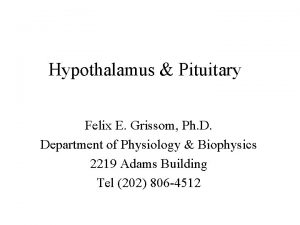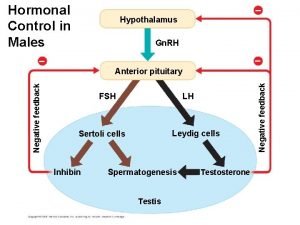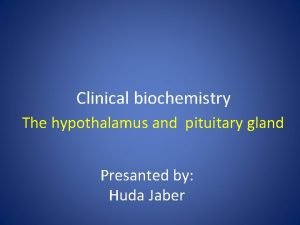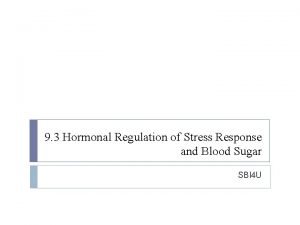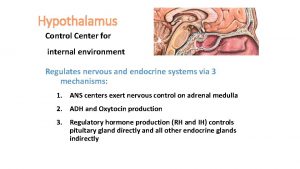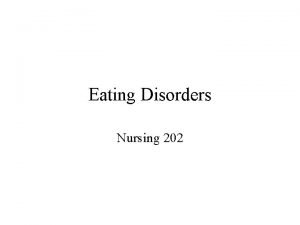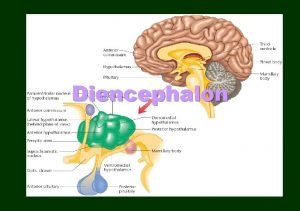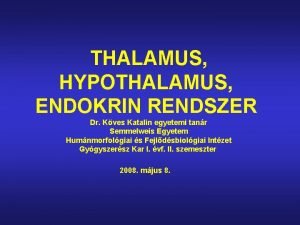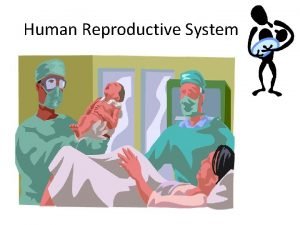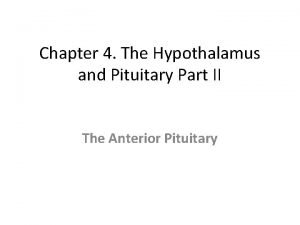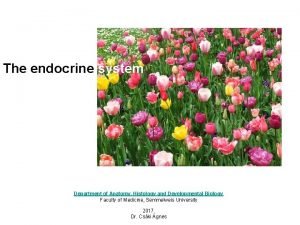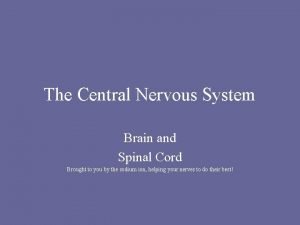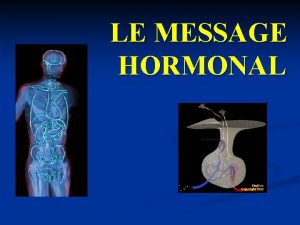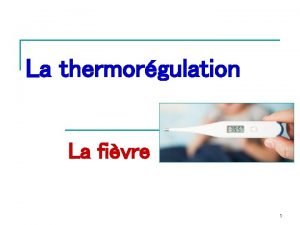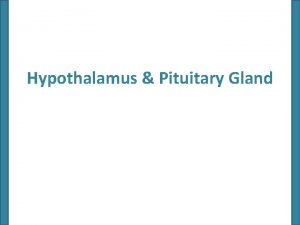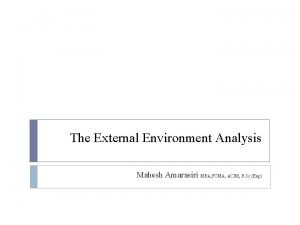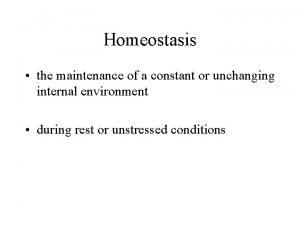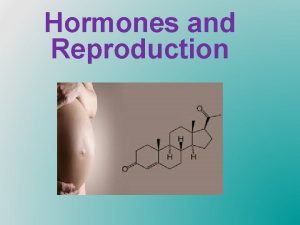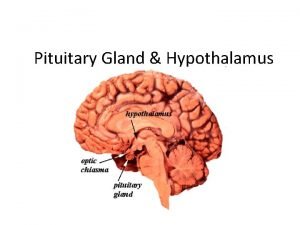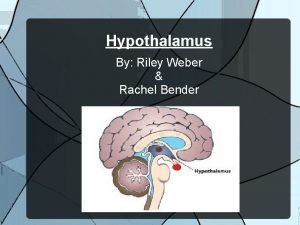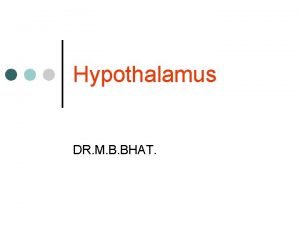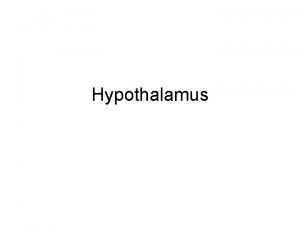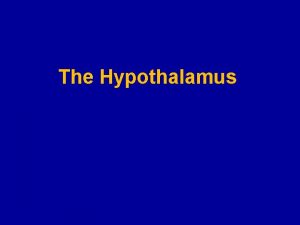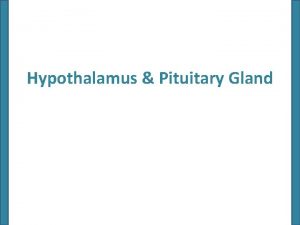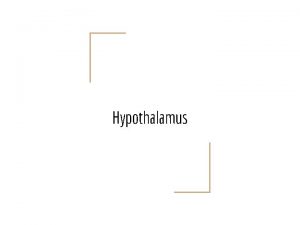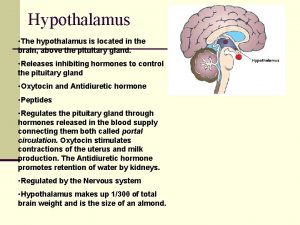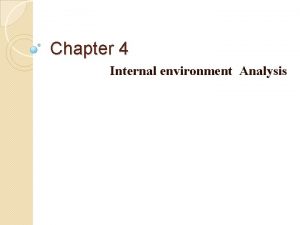Hypothalamus Control Center for internal environment Regulates nervous



























































































- Slides: 91

Hypothalamus Control Center for internal environment Regulates nervous and endocrine systems via 3 mechanisms: 1. ANS centers exert nervous control on adrenal medulla 2. ADH and Oxytocin production 3. Regulatory hormone production (RH and IH) controls pituitary gland directly and all other endocrine glands indirectly

Hypothalamus-Pituitary: Anatomy Hypothalamus: nervous tissue below thalamus Pituitary: small outgrowth of the forebrain, size of half a pea • Two functional parts – Adenohypophysis (anterior pituitary) – Neurohypophysis (posterior pituitary) • Move together during development

Hypothalamus • Integrates functions that maintain chemical and temperature homeostasis • Functions with the limbic system • Controls the release of hormones from the anterior and posterior pituitary

Hypothalamus • Synthesizes releasing hormones in cell bodies of neurons • Hormones are transported down the axon and stored in the nerve endings • Hormones are released in pulses

Hypothalamic Releasing Hormones Seven releasing hormones are made in the hypothalamus • • Thyrotropin-releasing hormone (TRH) Corticotropin-releasing hormone (CRH) Gonadotropin-releasing hormone (Gn. RH) Growth hormone-releasing hormone (GHRH) Growth hormone-release inhibiting hormone (GHIH) Prolactin-releasing factor (PRF) Prolactin-inhibiting hormone (PIH)

Figure 16. 4 c Three types of endocrine gland stimuli. Hormonal Stimulus Hormone release caused by another hormone (a tropic hormone). Hypothalamus Anterior pituitary gland Thyroid gland © 2013 Pearson Education, Inc. Adrenal Gonad cortex (Testis) Stimulus: Hormones from hypothalamus. Response: Anterior pituitary gland secretes hormones that stimulate other endocrine glands to secrete hormones. Slide 1

Hypothalamus Releasing Hormones: Secretion • Is influenced by emotions • Can be influenced by the metabolic state of the individual • Delivered to the anterior pituitary via the hypothalamic-hypophyseal portal system • Usually initiates a three-hormone sequence

Figure 16. 5 b The hypothalamus controls release of hormones from the pituitary gland in two different ways (2 of 2). Slide 1 Hypothalamus Anterior lobe of pituitary Superior hypophyseal artery 2 Hypothalamic hormones travel through portal veins to the anterior pituitary where they stimulate or inhibit release of hormones made in the anterior pituitary. 3 In response to releasing hormones, the anterior pituitary secretes hormones into the secondary capillary plexus. This in turn empties into the general circulation. GH, TSH, ACTH, FSH, LH, PRL Anterior lobe of pituitary © 2013 Pearson Education, Inc. Hypothalamic neurons synthesize GHRH, GHIH, TRH, CRH, Gn. RH, PIH. 1 When appropriately stimulated, hypothalamic neurons secrete releasing or inhibiting hormones into the primary capillary plexus. Hypophyseal portal system • Primary capillary plexus • Hypophyseal portal veins • Secondary capillary plexus A portal system is two capillary plexuses (beds) connected by veins.

Anterior Pituitary Is also called the Adenohypophysis Secretes trophic hormones in a pulsatile fashion Synthesizes various hormones in various specific cell populations

Anterior Pituitary Hormones Each of anterior pituitary hormone is synthesized by a cell population. Corticotropes - ACTH Lactotropes - Prolactin Somatotropes - GH Thyrotropes - Thyrotropin Gonadotropes - FSH, LH

Anterior Pituitary Hormones Thyroid-stimulating Hormone (TSH): stimulates secretion of thyroid hormone & growth of thyroid gland Growth Hormone (GH, Somatotropin): primary hormone responsible for regulating body growth, and is important in metabolism Adrenocorticotropic Hormone (ACTH): stimulates cortisol secretion by the adrenal cortex & promotes growth of adrenal cortex

Anterior Pituitary Hormones Follicle-stimulating Hormone (FSH): Females: stimulates growth & development of ovarian follicles, promotes secretion of estrogen by ovaries. Males: required for sperm production Luteinizing Hormone (LH): Females: responsible for ovulation, formation of corpus luteum in the ovary, and regulation of ovarian secretion of female sex hormones. Males: stimulates cell in the testes to secrete testosterone Prolactin: Females: stimulates breast development and milk production. Males: involved in testicular function

HYPOTHALAMIC HORMONE EFFECTS ON THE ANTERIOR PITUITARY Thyrotropin-releasing hormone (TRH) Stimulates release of TSH (thyrotropin) and Prolactin Corticotropin-releasing hormone Stimulates release of ACTH (CRH) (corticotropin) Gonadrotropin-releasing hormone (Gn. RH) Stimulates release of FSH and LH (gonadotropins) Growth hormone-releasing hormone (GHRH) Growth hormone-inhibiting hormone (GHIH) Stimulates release of growth hormone Inhibits release of growth hormone {Prolactin-inhibiting hormone (PIH) Stimulates release of prolactin Prolactin-inhibiting hormone (PIH) Inhibits release of prolactin












HYPOTHALAMIC HORMONE EFFECTS ON THE ANTERIOR PITUITARY Thyrotropin-releasing hormone (TRH) Stimulates release of TSH (thyrotropin) and Prolactin Corticotropin-releasing hormone Stimulates release of ACTH (CRH) (corticotropin) Gonadrotropin-releasing hormone (Gn. RH) Stimulates release of FSH and LH (gonadotropins) Growth hormone-releasing hormone (GHRH) Growth hormone-inhibiting hormone (GHIH) Stimulates release of growth hormone Inhibits release of growth hormone {Prolactin-inhibiting hormone (PIH) Stimulates release of prolactin Prolactin-inhibiting hormone (PIH) Inhibits release of prolactin

Corticotrophin-releasing hormone: • secreted by the paraventricular nucleus of the hypothalamus • CRH has several important actions • Central driver of the hypothalamic–pituitary–adrenal axis (stress system) • Main function is to stimulate secretion of adrenocorticotropic hormone from pituitary gland • ACTH in turn stimulates adrenal gland to secrete cortisol (stress hormone) • Other CRH functions in brain: v Suppress appetite v Increase anxiety v Improve memory and selective attention • Together, these effects co-ordinate behavior to develop and fine tune the body’s response to a stressful experience • CRH level increased during pregnancy by fetus and placenta • High level of CRH start labor • CRH also made from white blood cells • Where stimulates swelling or tenderness known as inflammation (particularly in gut)

CRH controlling: • By circadian rhythm (max at 8 am and min during night) • Increased by stress, infection and sport activities • CRH high level increase cortisol and it causes increasing available energy to deal with stress • Long term stress suppress hypothalamic–pituitary–adrenal axis • Cortisol has feed back suppression effect on CRH • Different levels of CRH causes some disease: v. Inflammation particularly in skin, stomach and joints v. Low levels of CRH have been observed in Alzheimer patients v. Low levels of CRH cause chronic fatigue syndrome v. Low levels of CRH during pregnancy can leads to abortion Human CRH: 41 amino acid peptide




• Proopiomelanocortin (POMC) is a precursor polypeptide with 266 amino acid residues (“big mama”) • POMC is synthesized in the pituitary from the 285 -amino-acid-long polypeptide precursor pre-proopiomelanocortin (pre-POMC), by the removal of a 44 -amino-acid-long signal peptide sequence • POMC is cleaved to give rise to multiple peptide hormones • POMC gene expressed in anterior and middle pituitary (also has been observed in brain, digestive and reproductive system, lymphocytes and placenta • Its processing is different in different cells (middle pituitary is inactive in human except in fetus and late pregnancy) • POMC processing occurs in basic amino acid locations by Trypsin like enzymes

ACTH: • 39 AA peptide with tropic and trophic effect on adrenal cortex • 24 amine terminal necessary for biological effect and protect among different species • Carboxyl terminal varied in different species • ACTH increases Cholesterol conversion to Pregnenolone in adrenal cortex • Pregnenolone is precursor to produce all of the adrenal cortex steroid hormones • ACTH has minor regulatory effect on mineralocorticoids and sex hormones production • c. AMP as secondary messenger for ACTH • Ca ion also cooperate with ACTH • High level of ACTH causes Cushing syndrome

β-LPH: • 91 AA from POMC carboxyl terminal • ɣ-LPH, β-MSH, β-endorphin and Met-encephalin sequences in β-LPH • β-LPH presents only in pituitary • It is converted to ɣ-LPH and β-endorphin in other tissues immediately • β-LPH causes fat decomposition and releasing fatty acids • β-endorphin (31 AA of C-terminal of β-LPH) • Gamma and alpha endorphin produced from β-endorphin • Endorphins present in acetylated (inactive form) in pituitary • De-acetylated (activated) in CNS and play as Neurotransmitter • Encephalin sequence present in POMC

MSH: • Melanocyte stimulating hormone • Three type of MSH in POMC (alpha, beta and gamma) • Addison disease (Inadequate production of glucocorticoids and high activity of MSH resulted in skin hyperpigmentation) • This can be seen in high levels of ACTH and beta and gamma lipoprotein




HYPOTHALAMIC HORMONE EFFECTS ON THE ANTERIOR PITUITARY Thyrotropin-releasing hormone (TRH) Stimulates release of TSH (thyrotropin) and Prolactin Corticotropin-releasing hormone Stimulates release of ACTH (CRH) (corticotropin) Gonadrotropin-releasing hormone (Gn. RH) Stimulates release of FSH and LH (gonadotropins) Growth hormone-releasing hormone (GHRH) Growth hormone-inhibiting hormone (GHIH) Stimulates release of growth hormone Inhibits release of growth hormone {Prolactin-inhibiting hormone (PIH) Stimulates release of prolactin Prolactin-inhibiting hormone (PIH) Inhibits release of prolactin



• The control of reproduction in females is more complex • Estrogen (estradiol) is the reproductive hormone in females that assists in endometrial regrowth, ovulation, and calcium absorption; it is also responsible for the secondary sexual characteristics of females. • Progesterone assists in endometrial re-growth and inhibition of FSH and LH release. • In females, FSH stimulates development of egg cells, called ova, which develop in structures called follicles. • Follicle cells produce the hormone inhibin, which inhibits FSH production. • LH also plays a role in the development of ova, induction of ovulation, and stimulation of estradiol and progesterone production by the ovaries • Estradiol and progesterone are steroid hormones that prepare the body for pregnancy. • Estradiol produces secondary sex characteristics in females, while both estradiol and progesterone regulate the menstrual cycle.

• The ovarian cycle governs the preparation of endocrine tissues and release of eggs • menstrual cycle governs the preparation and maintenance of the uterine lining • These cycles occur concurrently and are coordinated over a 22– 32 day cycle, with an average length of 28 days





HYPOTHALAMIC HORMONE EFFECTS ON THE ANTERIOR PITUITARY Thyrotropin-releasing hormone (TRH) Stimulates release of TSH (thyrotropin) and Prolactin Corticotropin-releasing hormone Stimulates release of ACTH (CRH) (corticotropin) Gonadrotropin-releasing hormone (Gn. RH) Stimulates release of FSH and LH (gonadotropins) Growth hormone-releasing hormone (GHRH) Growth hormone-inhibiting hormone (GHIH) Stimulates release of growth hormone Inhibits release of growth hormone {Prolactin-inhibiting hormone (PIH) Stimulates release of prolactin Prolactin-inhibiting hormone (PIH) Inhibits release of prolactin


What is growth hormone-releasing hormone? • The main role of GHRH is to stimulate the pituitary gland produce and release growth hormone • It virtually controls metabolism and growth • Growth hormone stimulates production of insulin-like growth factor 1 in the liver and other organs • Growth hormone-releasing hormone also affects sleep, food intake and memory


• Too much GHRH production may be caused by hypothalamic tumors or by tumors located in other parts of the body (ectopic tumors) • High levels of GHRH causes rise in GH levels in the bloodstream and, in many cases, enlargement of the pituitary gland • In adults, excessive GH for a long period of time produces a condition known as Acromegaly • These patients also have organ enlargement and serious functional disorders such as high blood pressure, diabetes and heart disease • High levels of GH leads to Gigantism • In most cases, growth hormone overproduction is caused by pituitary tumors that produce growth hormone; only in very rare occasions is excess growth hormone caused by overproduction of GHRH

Growth Hormone • 191 amino acids long • Protein structure • 4 helices that help it bind its receptor • 2 strong sulfide bonds hold the structure together • primary hormonal control is via positive regulation by GHRH and negative regulation by somatostatin • males have pulsatile secretion but females exhibit a continuous secretion • The most characterized role is in stimulating longitudinal bone growth • GH also impacts cell growth, differentiation, and metabolism, through coordinated actions on different tissues, including liver, adipose tissue, skeletal muscle, and bone




Posterior Pituitary Comprised of the endings of axons from cell bodies in the hypothalamus (supraoptic and paraventricular) Axons pass from the hypothalamus to the posterior pituitary via the hypothalamo hypophysial tract Posterior pituitary hormones are synthesized in the cell bodies of neurons in the supraoptic (ADH) and paraventricular nuclei(oxytocin)

Posterior Pituitary Hormones synthesized in the hypothalamus are transported down the axons to the endings in the posterior pituitary Hormones are stored in vesicles in the posterior pituitary until release into the circulation Principal Hormones: Vasopressin & Oxytocin

Secretion of Posterior Pituitary Hormones

Figure 16. 5 a The hypothalamus controls release of hormones from the pituitary gland in two different ways (1 of 2). Slide 1 Paraventricular nucleus Hypothalamus Posterior lobe of pituitary Optic chiasma Infundibulum (connecting stalk) Hypothalamichypophyseal tract Supraoptic nucleus Inferior hypophyseal artery Axon terminals 2 Oxytocin and ADH are transported down the axons of the hypothalamic- hypophyseal tract to the posterior pituitary. 3 Oxytocin and ADH are stored in axon terminals in the posterior pituitary. Posterior lobe of pituitary Oxytocin ADH © 2013 Pearson Education, Inc. 1 Hypothalamic neurons synthesize oxytocin or antidiuretic hormone (ADH). 4 When hypothalamic neurons fire, action potentials arriving at the axon terminals cause oxytocin or ADH to be released into the blood.

Oxytocin • Is synthesized as the precursor hormone: preprooxyphysin • Acts primarily on the mammary gland uterus • Increases contraction of smooth muscle of the vas deferens • Secretion is increased during labor • May also act to facilitate sperm transport in (non-pregnancy state) uterus

Posterior Pituitary: Regulation of Osmolality Plasma osmolality is monitored by osmoreceptors in the hypothalamus Increases in plasma osmolality stimulates secretion of vasopressin Small changes above the normal plasma osmotic pressure stimulate release of vasopressin

Vasopressin (ADH) Is also known as antiduretic hormone (ADH) Participates in body water regulation (Water is lost from lungs, sweat, feces and urine on a daily basis)

Vasopressin (ADH) Secretion is Stimulated by: 1. Large decreases in blood volume 2. Decreases in blood pressure 3. Pain, fear, trauma, and stress

Vasopressin Activity Decreases water excretion by kidneys (V 2 receptors) Constricts blood vessels (V 1 receptors)- arteriolar smooth muscle Increases adrenocorticortropin hormone (V 1 B receptors) secretion from the anterior pituitary




Hypothalamic and Pituitary Hormones Hypothalamic hormones regulate anterior pituitary trophic hormones that, in turn, determine target gland secretion. There is a peripheral hormones feedback which regulates hypothalamic and pituitary hormones.

Hormonal Stimuli • Hormones stimulate other endocrine organs to release their hormones • Hypothalamic hormones stimulate release of most anterior pituitary hormones • Anterior pituitary hormones stimulate targets to secrete still more hormones • Hypothalamic-pituitary-target endocrine organ feedback loop: hormones from final target organs inhibit release of anterior pituitary hormones © 2013 Pearson Education, Inc.

The Pituitary Gland Hypothalamus • Pituitary gland (hypophysis) has two major lobes • Posterior pituitary (lobe) • Neural tissue • Anterior pituitary (lobe) (adenohypophysis) • Glandular tissue © 2013 Pearson Education, Inc.

Posterior Pituitary and Hypothalamic Hormones • Oxytocin and ADH • Each composed of nine amino acids • Almost identical – differ in two amino acids © 2013 Pearson Education, Inc.

Corticotropin releasing hormone (CRH) – corticoliberin, is a hypothalamic polypeptide for diagnostic use. It increases ACTH secretion in Cushing's diseas. Natural corticotropin (ACTH) is a 39 -amino-acid polypeptide secreted by the anterior pituitary gland, obtained from animal pituitaries. The physiological activity resides in the first 24 -amino acids (which are common to many species) and most of the immunological activity resides in the remaining 15 amino acids. The pituitary output of corticotropin responds rapidly to physiological requirements by the familiar negative-feedback homeostatic mechanism.

Corticotropin stimulates the synthesis of corticosteroids (of which the most important is hydrocortisone) and to a lesser extent of androgens, by the cells of the adrenal cortex. It ha only a minor effect on aldosterone production. The release o natural corticotropin by the pituitary gland is controlled by t hypothalamus via corticotropin releasing hormone (corticoliberin), production of which is influenced by stress as well as by the level of circulating hydrocortisone.

High plasma concentration of any steroid with glucocorticoid effect prevents release of corticotropin releasing hormone as well as of ACTH, the lack of which in turn results in adrenocortical hypofunction. This is the reason why catastrophe may follow the sudden withdrawal of steroid therapy in the chronically treated patient who has an atrophied cortex. The effects of corticotropin are those of the steroids (hydrocortisone, androgens) liberated by its action on the adrenal cortex. Prolonged heavy dosage causes Cushing's syndrome. Tetracosactide (Synacthen®) is used as a test of

Thyrotropin releasing hormone (TRH) – protirelin, is a thripeptide formed in the hypothalamus and controlled by free plasma T 4 and T 3 concentration. It has been synthesized and can be used in diagnosis to test the capacity of the pituitary to release thyroid stimulating hormone, e. g. to determine whether hypothyroidism is due to primary thyroid gland failure or is secondary to pituitary disease or to a hypothalamic lesion. TRH is also a potent prolactin-releasing factor.

Thyroid stimulating hormone (TSH) thyrotropin a glycoprotein of the anterior pituitary, controls the synthesis and release of thyroid hormone from the gland, and also the uptake of iodide. There is a negative feedback of thyroid hormones on both the hypothalamic secretion of TRH and pituitary secretion of TSH. Sermorelin is an analogue of the hypothalamic growth hormone releasing hormone (somatorelin It is used in a diagnostic test for growth hormone secretion from the pituitary.

Growth hormone (GH), one of the peptide hormones produced by the anterior pituitary, is required during childhood and adolescence for attainment of normal adult size and has important effects throughout postnatal life on lipid and carbohydrate metabolism, and on body mass. Its effects are primarily mediated via insulin-like growth factor 1 (IGF-1) and IGF-2 Individuals with congenital or acquired deficiency in GH during childhood or adolescence fail to reach their predicted adult height and have disproportionately increased body fat and decreased muscle mass. Adults with GH deficiency also have disproportionately small body mass.

Gonadorelin (gonadotropin releasing hormone – Gn. RH) releases luteinising hormone (LH) and follicle-stimulating hormone (FSH). It has use in the assessment of pituitary function. Intermittent pulsatile administration evokes secretion of gonadotropins (LH and FSH) and is used to treat infertility. But continuous use evokes tachyphylaxis due to down-regulation of its receptors, i. e. gonadotropin release and therefore gonadal secretions are reduced. Longer-acting analogues – agonists of Gn. RH (buserelin, goserelin, nafarelin, deslorelin, and leuprorelin) are used to suppress androgen secretion in prostatic carcinoma.

Prolactin is secreted by the lactotroph cells of the anterior pituitary gland. Its control is by tonic hypothalamic inhibition through prolactin inhibitory factor (PIF), probably dopamine, opposed by a prolactin releasing factor (PRF) in both women and, despite its name, it influences numerous biological functions. Prolactin secretion is controlled by an inhibitory dopaminergic path. Hyperprolactinaemia may be caused by drugs (with antidopaminergic actions e. g. metoclopramide), hypothyroidism, or prolactin secreting adenomas. Medical treatment is with bromocriptine, cabergoline or quinagolide at bedtime.

Hypothalamic neurons in the supraoptic (SON) and paraventricular (PVN) nuclei synthesize arginine vasopressin (AVP) or oxytocin (OXY). Goodman & Gilman's The Pharmacologic Basis of Therapeutics – 11 th Ed. (2006) Most of their axons project directly to the posterior pituitary, from which AVP and OXY are secreted into the systemic circulation to regulate their target tissues.

Vasopressin is a nonapeptide (t 1/2 20 min) with two separate G-protein coupled target receptors responsible for its two roles. The V 1 receptor on vascular smooth muscle is coupled to calcium entry. This receptor is not usually stimulated by physiological concentrations of the hormone. The V 2 receptor is coupled to adenylyl cyclase, and regulates opening of the water channel, aquaporin, in cells of the renal collecting duct. Secretion of the antidiuretic hormone is stimulated by any increase in the osmotic pressure of the blood supplying the hypothalamus and by a variety of drugs, notably nicotine. Secretion is inhibited by a fall in blood osmotic pressure and by alcohol.

The main complication of DDAVP is hyponatraemia which can be prevented by allowing the patient to develop some polyuria for a short period during each week. The requirement for DDAVP may decrease during intercurrent illness. Terlipressin is an analogue of vasopressin used in NA-resistant septic shock and esophageal varices. Oxytocin is a peptide hormone of the posterior pituitary gland. It stimulates the contractions of the pregnant uterus, which becomes much more sensitive to it at term. Patients with posterior pituitary disease (diabetes insipidus) can, however, go into labour normally.

Oxytocin is structurally close to vasopressin and it is no surprise that it also has antidiuretic activity. Serious water intoxication can occur with prolonged i. v. infusions, especially where accompanied by large volumes of fluid. The association of oxytocin with neonatal jaundice appears to be due to increased erythrocyte fragility causing haemolysis. Oxytocin has been supplanted by the Methylergometrine (Methergin®), as the prime treatment of postpartum haemorrhage. Neonatal jaundice

Corticotropin releasing hormone (CRH) – corticoliberin, is a hypothalamic polypeptide for diagnostic use. It increases ACTH secretion in Cushing's diseas. Natural corticotropin (ACTH) is a 39 -amino-acid polypeptide secreted by the anterior pituitary gland, obtained from animal pituitaries. The physiological activity resides in the first 24 -amino acids (which are common to many species) and most of the immunological activity resides in the remaining 15 amino acids. The pituitary output of corticotropin responds rapidly to physiological requirements by the familiar negative-feedback homeostatic mechanism.

Corticotropin stimulates the synthesis of corticosteroids (of which the most important is hydrocortisone) and to a lesser extent of androgens, by the cells of the adrenal cortex. It ha only a minor effect on aldosterone production. The release o natural corticotropin by the pituitary gland is controlled by t hypothalamus via corticotropin releasing hormone (corticoliberin), production of which is influenced by stress as well as by the level of circulating hydrocortisone.

High plasma concentration of any steroid with glucocorticoid effect prevents release of corticotropin releasing hormone as well as of ACTH, the lack of which in turn results in adrenocortical hypofunction. This is the reason why catastrophe may follow the sudden withdrawal of steroid therapy in the chronically treated patient who has an atrophied cortex. The effects of corticotropin are those of the steroids (hydrocortisone, androgens) liberated by its action on the adrenal cortex. Prolonged heavy dosage causes Cushing's syndrome. Tetracosactide (Synacthen®) is used as a test of


Endocrine Control: Three Levels of Integration • Hypothalamic stimulation–from CNS • Pituitary stimulation–from hypothalamic trophic Hs • Endocrine gland stimulation–from pituitary trophic Hs

Endocrine Control: Three Levels of Integration

Feedback Control of Anterior Pituitary

Two hypothalamic factors, growth hormone-releasing hormone (GHRH) and somatostatin (SST), act on the somatotropes in the anterior pituitary to regulate GH secretion. SST also inhibits GHRH release. Ghrelin is a potent stimulator of GH release.
 Mla format regulates
Mla format regulates Which neuron is rare
Which neuron is rare Sensory input and motor output
Sensory input and motor output Neuron processes
Neuron processes System of internal controls
System of internal controls Internal control and internal check
Internal control and internal check Hypothalamus function in sleep
Hypothalamus function in sleep Hypothalamus ans
Hypothalamus ans Anterior nucleus
Anterior nucleus Circuit of papez
Circuit of papez Preoptic area hypothalamus
Preoptic area hypothalamus Hypothalamus
Hypothalamus Hypothalamus nuclei
Hypothalamus nuclei Myxedima
Myxedima Incentive theory ap psychology
Incentive theory ap psychology Calcitonin and pth are antagonistic hormones
Calcitonin and pth are antagonistic hormones Amegdala
Amegdala Factors affecting growth hormone
Factors affecting growth hormone N
N Hypothalamus and pituitary gland connection
Hypothalamus and pituitary gland connection Releasing inhibiting hormones
Releasing inhibiting hormones Fsh in males
Fsh in males Thalamus function
Thalamus function Hypothalamus hormones
Hypothalamus hormones Somatic nervous system neurotransmitters
Somatic nervous system neurotransmitters Hypothalamus epinephrine
Hypothalamus epinephrine 9 months
9 months Corticoliberin
Corticoliberin Endocrine organ
Endocrine organ Hypothalamus and eating disorders
Hypothalamus and eating disorders Hypothalamus
Hypothalamus Hypothalamus
Hypothalamus Epithalamus
Epithalamus Fertilization occurs
Fertilization occurs Hypothalamus gland
Hypothalamus gland Hypothalamus hormones
Hypothalamus hormones Zona glomerulosa produces
Zona glomerulosa produces Spinal cord structures
Spinal cord structures Le message hormonal
Le message hormonal Thermorgulation
Thermorgulation Pituitary gland
Pituitary gland Melanocortin
Melanocortin Financial environment in business environment
Financial environment in business environment Internal environment of an organization
Internal environment of an organization Components of internal business environment
Components of internal business environment Environment means
Environment means Slidetodoc.com
Slidetodoc.com Meaning of business environment in simple words
Meaning of business environment in simple words Internal business environment factors
Internal business environment factors Internal marketing environment
Internal marketing environment External environments and accountability of schools
External environments and accountability of schools Maintenance of a stable internal environment
Maintenance of a stable internal environment Internal and external business environment
Internal and external business environment Components of internal environment
Components of internal environment Maintenance of a constant internal environment
Maintenance of a constant internal environment Assessing the internal environment of the firm
Assessing the internal environment of the firm Fspos
Fspos Novell typiska drag
Novell typiska drag Tack för att ni lyssnade bild
Tack för att ni lyssnade bild Ekologiskt fotavtryck
Ekologiskt fotavtryck Shingelfrisyren
Shingelfrisyren En lathund för arbete med kontinuitetshantering
En lathund för arbete med kontinuitetshantering Adressändring ideell förening
Adressändring ideell förening Personlig tidbok för yrkesförare
Personlig tidbok för yrkesförare Anatomi organ reproduksi
Anatomi organ reproduksi Förklara densitet för barn
Förklara densitet för barn Datorkunskap för nybörjare
Datorkunskap för nybörjare Tack för att ni lyssnade bild
Tack för att ni lyssnade bild Hur skriver man en tes
Hur skriver man en tes Magnetsjukhus
Magnetsjukhus Nyckelkompetenser för livslångt lärande
Nyckelkompetenser för livslångt lärande Påbyggnader för flakfordon
Påbyggnader för flakfordon Arkimedes princip formel
Arkimedes princip formel Publik sektor
Publik sektor Bo bergman jag fryser om dina händer
Bo bergman jag fryser om dina händer Presentera för publik crossboss
Presentera för publik crossboss Argument för teckenspråk som minoritetsspråk
Argument för teckenspråk som minoritetsspråk Kanaans land
Kanaans land Treserva lathund
Treserva lathund Epiteltyper
Epiteltyper Claes martinsson
Claes martinsson Centrum för kunskap och säkerhet
Centrum för kunskap och säkerhet Lågenergihus nyproduktion
Lågenergihus nyproduktion Mat för idrottare
Mat för idrottare Verktyg för automatisering av utbetalningar
Verktyg för automatisering av utbetalningar Rutin för avvikelsehantering
Rutin för avvikelsehantering Smärtskolan kunskap för livet
Smärtskolan kunskap för livet Ministerstyre för och nackdelar
Ministerstyre för och nackdelar Tack för att ni har lyssnat
Tack för att ni har lyssnat Referatmarkeringar
Referatmarkeringar Redogör för vad psykologi är
Redogör för vad psykologi är Stål för stötfångarsystem
Stål för stötfångarsystem







